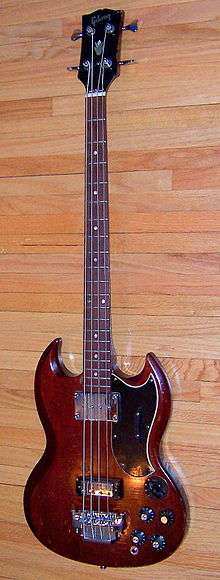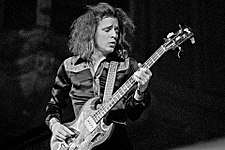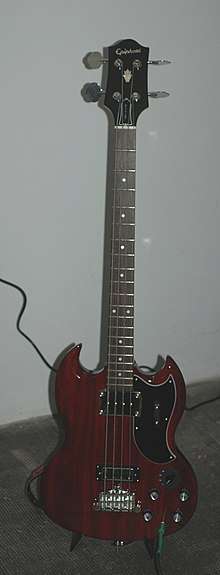Gibson EB-3
| Gibson EB-3 | |
|---|---|
 A 1967 Gibson EB-3 | |
| Manufacturer | Gibson Guitar Corporation |
| Period | 1961—1979 |
| Construction | |
| Body type | Solid |
| Neck joint | Set |
| Scale | 30.5" or 34" (EB-3L) |
| Woods | |
| Body | Mahogany, rarely walnut |
| Neck | Mahogany, maple (1973-1979), walnut (1974) |
| Fretboard | Brazilian rosewood |
| Hardware | |
| Bridge | Fixed |
| Pickup(s) | 1 humbucker (neck), 1 mini-humbucker (bridge) |
| Colors available | |
| "Heritage Cherry". Also available in Pelham Blue, Polaris White, Ebony and Walnut/Natural on custom-order. | |
The Gibson EB-3 is an electric bass guitar model produced by the Gibson Guitar Corporation.
Origins and history
Introduced in 1961, the EB-3 (based on an earlier model, the EB-0[1]) was one of the bass guitar equivalents of the popular Gibson SG. It was produced at Gibson's plant in Kalamazoo, MI[2]. It featured a slim SG-style body, a short 30.5" scale, and two pickups (a large humbucking pickup in the neck position and a mini-humbucker pickup in the bridge position). The electronics consisted of a four-way rotary pickup selector switch (for Series 1 basses; neck pickup with midrange notch, bridge, bridge and neck with low end rolled off neck pickup, neck pickup with choke) and volume and tone knobs for each pickup. The standard finish was cherry red (like the SG guitar models), though EB-3s were also produced in other finishes such as Polaris White, Pelham Blue, Walnut, and Ebony. By the time production ceased in 1979, a total of 14167 instruments had been built.[3]
The design of the EB-3 changed several times during the 1960s. In 1962, the black plastic cover on the neck pickup was replaced by a metal one. Around 1964-5, the nickel-plated hardware was replaced by chrome-plated. Around mid-1965, the wide control spacing from the early 1960s is reduced, giving all SG guitars and basses the same size and shape control cavity. Around 1966-7 the neck was replaced with a thinner one; the unadjustable bar bridge was replaced by a fully adjustable one with a nylon saddle for each string; the string guard was removed; a bridge guard was introduced and the knobs were replaced with the witch-hat design. In 1969 and 1970, the headstock was replaced with a slotted one (similar to those on most classical guitars), with tuning keys mounted at ninety degrees downwards behind the head. In 1972, the neck pickup is moved closer to the bridge, and maple with added volute instead of mahogany was used for the neck. In 1973 the 3 point bridge is used. In addition to the Gibson EB-3, a long-scale (34") model called the EB-3L was introduced for players who preferred the longer scale of most Fender basses. The EB-3 was discontinued in 1979.[1]
Gibson currently produces a model called the SG Bass[4] which is very similar to the EB-3, but with only a single tone control and no Varitone switch. Epiphone produces a more affordable EB-3 with a 34" scale (similar to the EB-3L), but the Varitone switch has been replaced by a simple pickup selector.[1][5]

Notable EB-3 players
- Jack Bruce switched from a Fender Bass VI to an EB-3 before the recording of Cream's Disraeli Gears (1967). Apparently, Bruce's bass, which he played for a decade, had a non-standard neck.
- Andy Fraser of Free also played an EB-3.[6]
- Bill Wyman of The Rolling Stones favored an EB-3 for most of the 1970s.
- Gerald Casale of Devo played an EB-3 during the band's pre-record label years in the 1970s.
- Glenn Cornick played an EB-3 for most of his last two years with Jethro Tull (1969–70).
- Pete Quaife of The Kinks sometimes used an EB-3 from May 1966 until his departure from the group in April 1969 along with a Rickenbacker 4001. His replacement, John Dalton also played the EB-3.[7]
- Trevor Bolder played an EB-3 with David Bowie's Spiders from Mars band in the early 1970s.
- Doug Yule played an EB-3 in The Velvet Underground.
- Jim Lea played an EB-3 in Slade during their most successful period in the early 1970s.
- Chris White of The Zombies played an EB-3 as well.
- Bob Daisley played an EB-3 on Ozzy Osbourne's Blizzard of Ozz (1980) and on many other albums.
- Peter Cetera played an EB-3 with Chicago during the early 1970s.
- Dee Murray played an EB-3 with Elton John's band in the 1970s.
- Nick St. Nicholas played an EB-3 with Steppenwolf in 1969.

References
- 1 2 3 Drozdowski, Ted (12 May 2010). "The Cream of Jack Bruce: The EB-3 Legend's Essential CDs". Gibson Guitar Corporation. Retrieved 24 November 2011.
- ↑ "Gibson EB3 bass". Retrieved 21 January 2018.
- ↑ "Gibson EB-3". Retrieved 27 July 2012.
- ↑ "SG Bass". Retrieved 16 June 2014.
- ↑ "Epiphone EB-3". Epiphone.com.
- ↑ "Gibson Bass Interview with Andy Fraser". gibsonbass.com.
- ↑ "Dave Davies Remembers Kinks Bassist Pete Quaife". Bassplayer. 2010-06-23. Retrieved 2014-06-13.